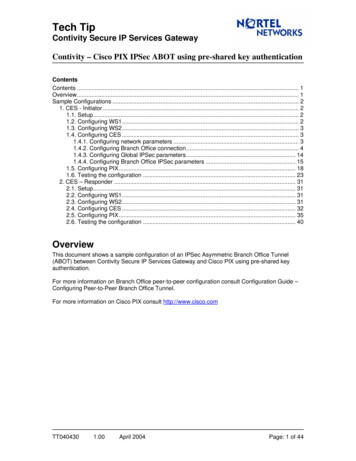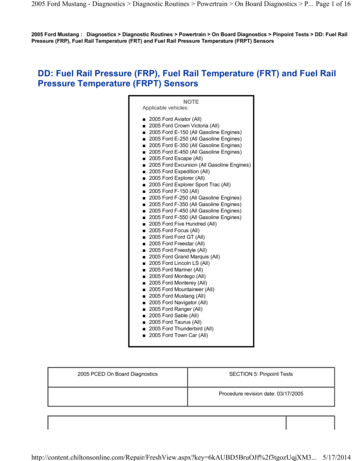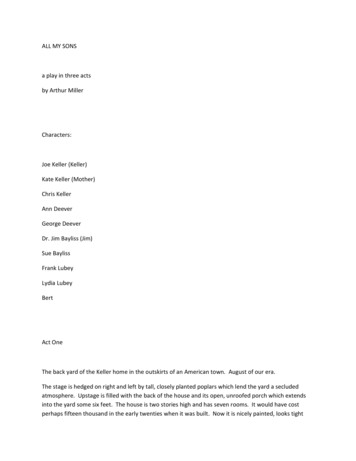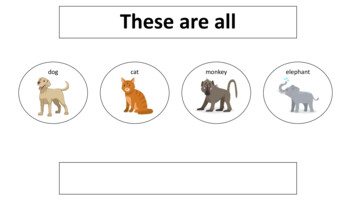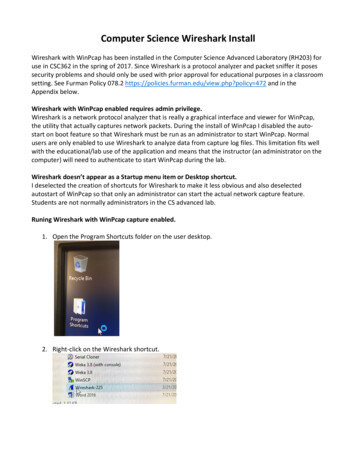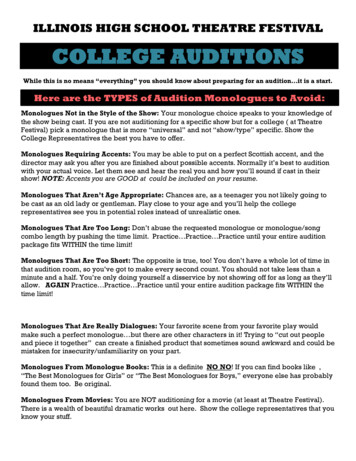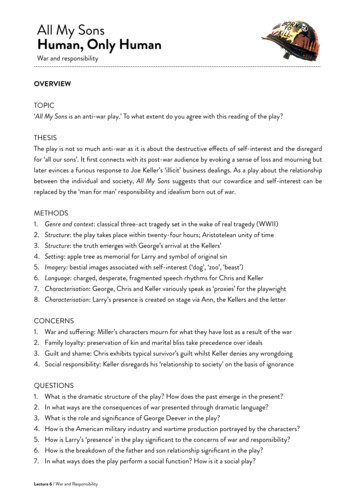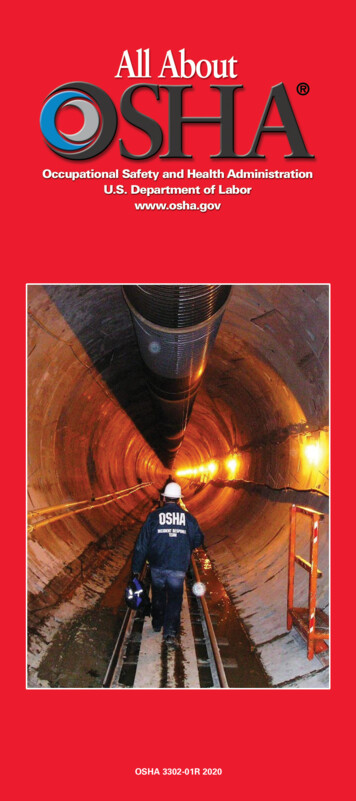
Transcription
OSHA3302-01R2020ALLA B OUTO SHA1
This booklet provides a general overview of basictopics related to OSHA and how it operates.Information provided does not determinecompliance responsibilities under OSHAstandards or the Occupational Safety and HealthAct of 1970 (OSH Act).Because interpretations and enforcement policymay change over time, you should consult theagency for the most up-to-date information.Much of it is available at the OSHA website atwww.osha.gov. The website also includeslocations and phone numbers for OSHA officesaround the country. If you do not have accessto the website, call 1-800-321-OSHA (6742). Thisinformation is available to sensory-impairedindividuals upon request. Voice phone: (202) 6931999; teletypewriter (TTY) number: (877) 889-5627.Material in this publication is in the publicdomain and may be reproduced, fully or partially,without permission. Source credit is requestedbut not required.Cover photo: Steve Baranowski, Braintree, MassachusettsArea Office
All About OSHAU.S. Department of LaborOccupational Safety and Health AdministrationOSHA 3302-01R 2020U.S. Department of Labor
ContentsOSHA’s Mission . . . 4Introduction . . . 4OSHA Coverage . . . 5Rights and Responsibilities underOSHA Law . . . 9OSHA Standards . . . 11Enforcement . . . 14General Reporting andRecordkeeping Requirements . . . 17Filing a Complaint . . . 18OSHA’s Whistleblower Program:Protection from Retaliation . . . 19If There is a Dangerous Situationat Work . . . 20Additional Whistleblower Protections . . . 21OSHA Assistance, Services,and Programs . . . 27OSHA Advisory Committees . . . 30OSHA Regional Offices . . . 31How to Contact OSHA . . . 332OCCUPATIONAL SAFETY AND HEALTH ADMINISTRATION
In 1970, the United States Congress and PresidentRichard Nixon created the Occupational Safetyand Health Administration (OSHA), a nationalpublic health agency dedicated to the basicproposition that no worker should have to choosebetween their life and their job.Passed with bipartisan support, the creation ofOSHA was a historic moment of cooperativenational reform. The OSHA law makes it clear thatthe right to a safe workplace is a basic human right.Since OSHA’s first day on the job, the agencyhas delivered remarkable progress for our nation.Workplace injuries, illnesses and fatalities havefallen dramatically. Together with our statepartners, OSHA has tackled fatal safety hazardsand health risks. We have established commonsense standards and enforced the law againstthose who put workers at risk. Our standards,enforcement actions, compliance assistance andcooperative programs have saved thousands oflives and prevented countless injuries and illnesses.Looking to the future, OSHA is committed toprotecting workers from toxic chemicals andfatal safety hazards at work, ensuring thatvulnerable workers in high-risk jobs have accessto critical information and education about jobhazards, and providing employers with vigorouscompliance assistance to promote best practicesthat can save lives.Although our task is far from complete, ourprogress gives us hope and confidence thatOSHA will continue to make a lasting differencein the lives of our nation’s workers, their familiesand their communities.A L L A B OUT O SHA3
OSHA’s MissionCongress created OSHA to assure safe andhealthful conditions for working men and womenby setting and enforcing standards and providingtraining, outreach, education and complianceassistance.Under the OSHA law, employers are responsiblefor providing a safe and healthful workplace fortheir workers. For more information, visit OSHA’swebsite at www.osha.gov.IntroductionPhoto: James MajorsOn December 29, 1970, President Nixon signedthe Occupational Safety and Health Act of 1970(OSH Act) into law, establishing OSHA. Coupledwith the efforts of employers, workers, safety andhealth professionals, unions and advocates,OSHA and its state partners have dramaticallyimproved workplace safety, reducing work-relatedfatalities by almost 63 percent.In 1970, an estimated 14,000 workers were killedon the job – about 38 every day. For 2018, theBureau of Labor Statistics reports this number fellto about 5,250 or about 14 workers per day. Atthe same time, U.S. employment has more thandoubled to over 146 million workers at more than4OCCUPATIONAL SAFETY AND HEALTH ADMINISTRATION
10 million worksites. The rate of reported seriousworkplace injuries and illnesses has also droppedmarkedly, from 10.9 per 100 workers in 1972 to2.8 per 100 workers in 2018.OSHA’s safety and health standards, includingthose for asbestos, fall protection, cotton dust,trenching, machine guarding, benzene, lead andbloodborne pathogens have prevented countlesswork-related injuries, illnesses and fatalities.Nevertheless, far too many preventable injuriesand fatalities continue to occur. Significanthazards and unsafe conditions still exist in U.S.workplaces; each year more than 3.5 millionworking men and women suffer a seriousjob-related injury or illness. Millions more areexposed to toxic chemicals that may causeillnesses years from now.In addition to the direct impact on individualworkers, the negative consequences for America’seconomy are substantial. Occupational injuriesand illnesses cost American employers more than 97.4 billion a year in workers’ compensationcosts alone. Indirect costs to employers,including lost productivity, employee training andreplacement costs, and time for investigationsfollowing injuries can more than double thesecosts. Workers and their families suffer greatemotional and psychological costs, in addition tothe loss of wages and the costs of caring for theinjured, which further weakens the economy.OSHA CoverageThe OSH Act covers most private sectoremployers and their workers, in addition tosome public sector employers and workersin the 50 states and certain territories andjurisdictions under federal authority. Thosejurisdictions include the District of Columbia,Puerto Rico, the Virgin Islands, AmericanSamoa, Guam, Northern Mariana Islands,A L L A B OUT O SHA5
Wake Island, Johnston Island, and the OuterContinental Shelf Lands as defined in the OuterContinental Shelf Lands Act.Private Sector WorkersOSHA covers most private sector employers andworkers in all 50 states, the District of Columbia,and other U.S. jurisdictions either directly throughFederal OSHA or through an OSHA-approvedstate plan.State plans are OSHA-approved job safety andhealth programs operated by individual statesinstead of Federal OSHA. The OSH Act encouragesstates to develop and operate their own jobsafety and health programs and precludes stateenforcement of OSHA standards unless the statehas an approved program. OSHA approves andmonitors all state plans and provides as muchas fifty percent of the funding for each program.State-run safety and health programs must be atleast as effective as the Federal OSHA program.To find the contact information for the OSHAfederal or state plan office nearest you, call 1-800321-OSHA (6742) or go to www.osha.gov.The following 22 states or territories haveOSHA-approved state programs: Alaska Arizona California Hawaii Indiana Iowa Kentucky Maryland Michigan Minnesota Nevada New Mexico North Carolina Oregon Puerto Rico South Carolina Tennessee Utah Vermont Virginia Washington Wyoming6OCCUPATIONAL SAFETY AND HEALTH ADMINISTRATION
OSHA-Approved State LGAPRLAFLVIOSHA-approved state plans (private sector andpublic employees)Federal OSHA (private sector and most federal employees)OSHA-approved state plans (for public employees only;private sector employees are covered by Federal OSHA)Federal OSHA provides coverage to certainworkers specifically excluded from a state’s plan,for example, those in some states who work inmaritime industries or on military bases.Any interested person or group, includingindividual workers, with a complaint concerningthe operation or administration of a state programmay submit a complaint to the appropriateFederal OSHA regional administrator (regionaloffices are listed at the end of this guide). Thisis called a Complaint About State ProgramAdministration (CASPA). The complainant’s namewill be kept confidential. The OSHA regionaladministrator will investigate all such complaints,and where complaints are found to be valid, mayrequire appropriate corrective action on the partof the state.A L L A B OUT O SHA7
State and Local Government WorkersWorkers at state and local government agenciesare not covered by Federal OSHA, but have OSHAct protections if they work in those states thathave an OSHA-approved state program.OSHA rules also permit states and territories todevelop plans that cover only public sector (stateand local government) workers. In these cases,private sector workers and employers remainunder Federal OSHA jurisdiction. Five additionalstates and one U.S. territory have OSHA-approvedstate plans that cover public sector workers only: Connecticut Illinois Maine New Jersey New York Virgin IslandsFederal Government WorkersOSHA’s protection applies to all federal agencies.Section 19 of the OSH Act makes federal agencyheads responsible for providing safe andhealthful working conditions for their workers.Although OSHA does not fine federal agencies,it does monitor these agencies and conductsfederal workplace inspections in response toworkers’ reports of hazards.Federal agencies must have a safety and healthprogram that meets the same standards asprivate employers. Under a 1998 amendment, theOSH Act covers the U.S. Postal Service the sameas any private sector employer.Not Covered under the OSH Act The self-employed; Immediate family members of farmemployers; and Workplace hazards regulated by anotherfederal agency (for example, the Mine Safetyand Health Administration, the Department ofEnergy, or the Coast Guard).8OCCUPATIONAL SAFETY AND HEALTH ADMINISTRATION
Rights and Responsibilities underOSHA LawEmployers have the responsibility to provide asafe workplace. Employers MUST provide theirworkers with a workplace that does not haveserious hazards and must follow all OSHA safetyand health standards. Employers must find andcorrect safety and health problems. OSHA furtherrequires that employers must first try to eliminateor reduce hazards by making feasible changes inworking conditions rather than relying on personalprotective equipment such as masks, gloves, orearplugs. Switching to safer chemicals, enclosingprocesses to trap harmful fumes, or usingventilation systems to clean the air are examplesof effective ways to eliminate or reduce risks.Employers MUST also: Prominently display the official OSHA JobSafety and Health – It’s the Law poster thatdescribes rights and responsibilities underthe OSH Act. This poster is free and can bedownloaded from www.osha.gov. Inform workers about chemical hazards throughtraining, labels, alarms, color-coded systems,chemical information sheets and other methods. Provide safety training to workers in alanguage and vocabulary they can understand. Keep accurate records of work-relatedinjuries and illnesses. Perform tests in the workplace, such as airsampling, required by some OSHA standards. Provide required personal protectiveequipment at no cost to workers.* Provide hearing exams or other medical testsrequired by OSHA standards. Post OSHA citations and injury and illnessdata where workers can see them.A L L A B OUT O SHA9
Notify OSHA within 8 hours of a workplacefatality or within 24 hours of any work-relatedinpatient hospitalization, amputation or loss ofan eye (1-800-321-OSHA [6742]).Not retaliate against workers for using theirrights under the law, including their right toreport a work-related injury or illness.* Employers must pay for most types of required personalprotective equipment.Under OSHA law, workers are entitled to workingconditions that do not pose a risk of serious harm.Workers have the right to: File a confidential complaint with OSHA tohave their workplace inspected. Receive information and training abouthazards, methods to prevent harm, and theOSHA standards that apply to their workplace.The training must be done in a language andvocabulary workers can understand. Receive copies of records of work-related injuriesand illnesses that occur in their workplace. Receive copies of the results from tests andmonitoring done to find and measure hazardsin their workplace. Receive copies of their workplace medicalrecords. Participate in an OSHA inspection and speak inprivate with the inspector. File a complaint with OSHA if they have beenretaliated against by their employer as theresult of requesting an inspection or usingany of their other rights under the OSH Act. File a complaint if punished or retaliatedagainst for acting as a “whistleblower” underthe more than 20 federal laws for whichOSHA has jurisdiction.For more information, visit OSHA’s Workers’Rights page at www.osha.gov/workers.10OCCUPATIONAL SAFETY AND HEALTH ADMINISTRATION
OSHA StandardsPhoto: iStockOSHA’s Construction, General Industry, Maritimeand Agriculture standards protect workers from awide range of serious hazards. Examples of OSHAstandards include requirements for employers to: provide fall protection; prevent trenching cave-ins; prevent exposure to some infectious diseases; ensure the safety of workers who enterconfined spaces; prevent exposure to harmful chemicals; put guards on dangerous machines; provide respirators or other safetyequipment; and provide training for certain dangerous jobs ina language and vocabulary workers canunderstand.Employers must also comply with the GeneralDuty Clause of the OSH Act. This clause requiresemployers to keep their workplaces free of seriousrecognized hazards and is generally cited whenno specific OSHA standard applies to the hazard.A L L A B OUT O SHA11
Photo: iStockThe Standards-Setting ProcessOSHA has the authority to issue new or revisedoccupational safety and health standards. TheOSHA standards-setting process involves manysteps and provides many opportunities for publicengagement. OSHA can begin standards-settingprocedures on its own initiative or in responseto recommendations or petitions from otherparties, including: The National Institute for OccupationalSafety and Health (NIOSH), the researchagency for occupational safety and health.(For more information, call 1-800-CDC-INFO(1-800-232-4636) or visit the agency’s websiteat www.cdc.gov/niosh); State and local governments; Nationally recognized standards-producingorganizations; Employer or labor representatives; and Any other interested parties.When OSHA is considering whether to developa new or revised standard, the Agency oftenpublishes a Request for Information (RFI) oran Advance Notice of Proposed Rulemaking12OCCUPATIONAL SAFETY AND HEALTH ADMINISTRATION
(ANPRM) in the Federal Register to obtaininformation and views from interested membersof the public. OSHA will also frequently holdstakeholder meetings with interested partiesto solicit information and opinions on how theAgency should proceed with the regulation.When OSHA publishes an RFI or ANPRM,interested parties can submit written commentsat www.regulations.gov, where all informationand submissions are made public.If OSHA decides to proceed with issuing a newor revised regulation, it must first publish aNotice of Proposed Rulemaking (NPRM) in theFederal Register and solicit public comment. TheNPRM contains a proposed standard along withOSHA’s explanation of the need for the variousrequirements in that proposed standard.Interested parties are invited to submit writtencomments through www.regulations.gov,and OSHA will often hold public hearings inwhich stakeholders can offer testimony andprovide information to assist the Agency indeveloping a final standard. After consideringall of the information and testimony provided,OSHA develops and issues a final standard thatbecomes enforceable.Each spring and fall, the Department of Laborpublishes in the Federal Register a list of allregulatory projects underway. The RegulatoryAgenda provides a projected schedule for theseprojects to inform stakeholders of the Agency’sregulatory priorities and enable interested partiesto take advantage of opportunities to participate inthe regulatory process. Current and past issues ofthe Regulatory Agenda can be accessed on OSHA’sLaw and Regulations page at www.osha.gov/law-regs.A L L A B OUT O SHA13
Input from Small BusinessThe Small Business Regulatory Enforcement FairnessAct of 1996 (SBREFA) gives small businesseshelp in understanding and complying with OSHAregulations and allows them a voice in developingnew regulations. Under SBREFA, OSHA must: Produce Small Entity Compliance Guides forsome agency rules; Be responsive to small business inquiries aboutcomplying with the Agency’s regulations; Submit final rules to Congress for review; Have a penalty reduction policy for smallbusinesses; and Involve small businesses in developingproposed rules expected to significantly affecta large number of small entities through SmallBusiness Advocacy Review Panels.More information about OSHA standards and thestandards-setting process is available on OSHA’swebsite at www.osha.gov. Standards can beviewed on OSHA’s Law and Regulations page atwww.osha.gov/law-regs.EnforcementOSHA Inspection Activities:Carrying Out Our MissionEnforcement plays an important part in OSHA’sefforts to reduce workplace injuries, illnesses, andfatalities. When OSHA finds employers who fail touphold their safety and health responsibilities, theagency takes strong, decisive actions.Inspections are initiated without advance notice,conducted using on-site or telephone andfacsimile investigations, performed by highlytrained compliance officers and scheduled basedon the following priorities: Imminent danger; Catastrophes – fatalities or hospitalizations; Worker complaints and referrals;14OCCUPATIONAL SAFETY AND HEALTH ADMINISTRATION
Targeted inspections – particular hazards, highinjury rates; andFollow-up inspections.Photo: Aaron Sussell, Cincinnati, OhioCurrent workers or their representatives may filea written complaint and ask OSHA to inspect theirworkplace if they believe there is a serious hazardor that their employer is not following OSHAstandards. Workers and their representatives havethe right to ask for an inspection without OSHAtelling their employer who filed the complaint. Itis a violation of the OSH Act for an employer tofire, demote, transfer or in any way retaliateagainst a worker for filing a complaint or usingother OSHA rights.The on-site inspection begins with thepresentation of the compliance officer’scredentials. The compliance officer will explainwhy OSHA selected the workplace for inspectionand describe the scope of the inspection process,walkaround procedures, employee representationand employee interviews. Following the openingconference, the compliance officer and therepresentatives will walk through portions of theworkplace covered by the inspection, inspectingA L L A B OUT O SHA15
for hazards that could lead to worker injury orillness. After the walkaround, the complianceofficer will hold a closing conference with theemployer and the employee representative todiscuss the findings.When an inspector finds violations of OSHAstandards or serious hazards, OSHA may issuecitations and fines. A citation includes methods anemployer may use to fix a problem and the date bywhich the corrective actions must be completed.Employers have the right to contest any partof the citation, including whether a violationactually exists. Workers only have the right tochallenge the deadline by which a problem mustbe resolved. Appeals of citations are heard bythe independent Occupational Safety and HealthReview Commission (OSHRC). To contact theOSHRC, visit www.oshrc.gov or call (202) 606-5370.OSHA carries out its enforcement activitiesthrough its 10 regional offices and 89 area offices.OSHA’s regional offices are located in Boston,New York City, Philadelphia, Atlanta, Chicago,Dallas, Kansas City, Denver, San Francisco andSeattle. Contact information for each regionaloffice is available at the end of this guide.Severe Violator Enforcement ProgramOSHA’s Severe Violator Enforcement Program(SVEP) became effective on June 18, 2010.The program focuses enforcement efforts onemployers who willfully and repeatedly endangerworkers by exposing them to serious hazards.The SVEP directive establishes procedures andenforcement actions for these violators, includingmandatory follow-up inspections of workplacesfound in violation and inspections of otherworksites of the same company where similarhazards or deficiencies may be present. Visitwww.osha.gov for more information.16OCCUPATIONAL SAFETY AND HEALTH ADMINISTRATION
General Reporting andRecordkeeping RequirementsOSHA’s Reporting RequirementsAll employers must report to OSHA: The death of any worker from a work-relatedincident within 8 hours of learning about it; Any work-related inpatient hospitalization,amputation, or loss of an eye within 24 hours.For more information, visit www.osha.gov/report.In addition, employers must report all fatalheart attacks that occur at work. Fatal injuriesfrom motor vehicle accidents on public streets(except those in a construction work zone) andin accidents on commercial airplanes, trains,subways or buses do not need to be reported.These reports may be made by telephone or inperson to the nearest OSHA area office listedat www.osha.gov or by calling OSHA’s toll-freenumber, 1-800-321-OSHA (6742).OSHA’s Recordkeeping RequirementsTracking and investigating workplace injuries andillnesses play an important role in preventingfuture injuries and illnesses, and for that reason,OSHA requires certain covered employers in highhazard industries to prepare and maintain recordsof serious work-related injuries and illnesses.Employers with more than ten employees andwhose establishments are not classified as apartially exempt industry must record seriouswork-related injuries and illnesses using OSHAForms 300, 300A and 301, which are availableat www.osha.gov/recordkeeping/RKforms. html.A list of partially exempt industries, includingestablishments in specific low hazard retail, service,finance, insurance or real estate industries isavailable at l. Employers who are requiredA L L A B OUT O SHA17
to keep Form 300, the Injury and Illness log, mustalso post Form 300A, the Summary of WorkRelated Injuries and Illnesses, in the workplaceevery year from February 1 to April 30. For moreinformation, visit www.osha.gov/recordkeeping.Employers and workers need accurate, timelyinformation to focus their prevention activities,and OSHA uses this information for manypurposes, including inspection targeting,performance measurement, standardsdevelopment and resource allocation. Injury andillness data also aid employers and workers inidentifying possible safety and health hazards atthe employer’s establishment. OSHA encouragesemployers to review and investigate patternsof injuries and illnesses, and to conductinvestigations of injuries and near misses toprevent similar events in the future.OSHA is responsible for administering therecordkeeping system established by theOSH Act. OSHA’s recordkeeping regulationsprovide specific recording and reportingrequirements which comprise the framework forthe nationwide occupational safety and healthrecordkeeping system. For more informationabout OSHA’s recordkeeping requirements visitwww.osha.gov/recordkeeping.Filing a ComplaintHazardous Workplace ComplaintsIf a workplace has unsafe or unhealthful workingconditions, workers may want to file a complaint.Often the best and fastest way to get a hazardcorrected is to notify a supervisor or employer.Workers or their representatives may file acomplaint online or by phone, mail, email or faxwith the nearest OSHA office and request aninspection. A worker may also ask OSHA not toreveal his or her name. To file a complaint, call18OCCUPATIONAL SAFETY AND HEALTH ADMINISTRATION
1-800-321-OSHA (6742) or contact the nearestOSHA regional, area, state plan, or consultationoffice listed at www.osha.gov. The teletypewriter(TTY) number is (877) 889-5627.Written, signed complaints submitted to OSHA areaoffices are more likely to result in an on-site OSHAinspection. Most online or unsigned complaintsare resolved informally over the phone with theemployer. Complaints from workers in states withan OSHA-approved state plan will be forwarded tothe appropriate state plan for response.Workers can call 1-800-321-OSHA (6742) torequest a complaint form from their localOSHA office or visit www.osha.gov/pls/osha7/eComplaintForm.html to submit the form online.Completed forms can also be faxed or mailed tothe local OSHA office (provided at the end of thisguide). Include your name, address and telephonenumber so that OSHA can contact you.OSHA’s Whistleblower Program:Protection from RetaliationTo help ensure that workers are free to participatein safety and health activities, Section 11(c) of theOSH Act prohibits any person from dischargingor in any manner retaliating against any workerfor exercising rights under the OSH Act. Theserights include raising safety and health concernswith an employer, reporting a work-related injuryor illness, filing a complaint with OSHA, seekingan OSHA inspection, participating in an OSHAinspection and participating or testifying in anyproceeding related to an OSHA inspection.Protection from retaliation means that anemployer cannot retaliate by taking “adverseaction” against workers, such as: Firing or laying off; Blacklisting; Demoting;A L L A B OUT O SHA19
Denying overtime or promotion;Disciplining;Denying of benefits;Failing to hire or rehire;Intimidation;Making threats;Reassignment affecting prospects forpromotion; orReducing pay or hours.If a worker believes an employer has retaliatedagainst them for exercising their safetyand health rights, they should contact theirlocal OSHA office right away. You must filea retaliation complaint with OSHA within30 calendar days from the date the retaliatorydecision has been both made and communicatedto the worker. No form is needed, but workersmust call OSHA within 30 days of the allegedretaliation (at 1-800-321-OSHA [6742]). For moreinformation, please visit www.whistleblowers.gov.If There is a Dangerous Situation at WorkIf a worker believes working conditions areunsafe or unhealthful, OSHA recommends thathe or she bring the conditions to the employer’sattention, if possible. A worker may file acomplaint with OSHA concerning a hazardousworking condition at any time. However, workersshould not leave the worksite merely becausethey have filed a complaint. If the conditionclearly presents a risk of death or seriousphysical harm, there is not sufficient time forOSHA to inspect, and, where possible, a workerhas brought the condition to the attention of theemployer, the worker may have a legal right torefuse to work in a situation in which he or shewould be exposed to the hazard.If a worker, with no reasonable alternative, refusesin good faith to expose himself or herself to adangerous condition, he or she would be protected20OCCUPATIONAL SAFETY AND HEALTH ADMINISTRATION
Photo: Frank Wenzel, Washington DOSHfrom subsequent retaliation. The condition must beof such a nature that a reasonable person wouldconclude that there is a real danger of death orserious harm and that there is not enough timeto contact OSHA and for OSHA to inspect. Wherepossible, the worker must have also sought fromhis or her employer, and been unable to obtain, acorrection of the condition. For more information,go to www.osha.gov/workers.Additional Whistleblower ProtectionsSince passage of the OSH Act in 1970, Congresshas expanded OSHA’s whistleblower protectionauthority to protect workers from retaliationunder more than 20 federal laws. These lawsprotect workers who report violations of variousworkplace safety, airline, commercial motorcarrier, consumer product, environmental,financial reform, healthcare reform, nuclear,pipeline, public transportation agency, railroad,maritime, securities, and tax laws. Complaintsmust be reported to OSHA within set timeframesA L L A B OUT O SHA21
following the retaliatory action, as prescribed byeach law. These laws, and the number of daysworkers have to file a complaint, are:Worker, Environmental and NuclearSafety Laws Asbestos Hazard Emergency ResponseAct (AHERA) (90 days). Provides retaliationprotection for individuals who reportviolations of environmental laws relatingto asbestos in public or private nonprofitelementary and secondary school systems. Clean Air Act (CAA) (30 days). Providesretaliation protection for employees who,among other things, report violations of thislaw, which provides for the development andenforcement of standards regarding air qualityand air pollution. Comprehensive Environmental Response,Compensation, and Liability Act (CERCLA)(30 days). Protects employees who reportregulatory violations involving accidents,spills, and other emergency releases ofpollutants into the environment. The law alsoprotects employees who report violationsrelated to the cleanup of uncontrolled orabandoned hazardous waste sites. Energy Reorganization Act (ERA) (180 days).Protects certain employees in the nuclearindustry who report violations of the AtomicEnergy Act (AEA). Protected employeesinclude employees of operators, contractorsand subcontractors of nuclear powerplants licensed by the Nuclear RegulatoryCommission, and employees of contractorsworking with the Department of Energy undera contract pursuant to the Atomic Energy Act. Federal Water Pollution Control Act (FWPCA)(also known as the Clean Water Act)(30 days). Provides retaliation
markedly, from 10.9 per 100 workers in 1972 to 2.8 per 100 workers in 2018. OSHA’s safety and health standards, including those for asbestos, fall protection, cotton dust, trenching, machine guarding, benzene, lead and bloodborne pathogens have prevented c
